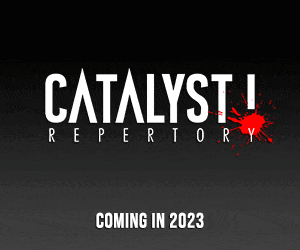
Top Row L-R- Matt Branic, Judy Fitzgerald, Tiffanie Bridges & Alex Campea. Middle Row L-R – Quincy Carman, Tiffany Gilliam & Luke Weber. Bottom Row L-R Cody Stiglich, Eric Olson, Sydney Howard & Maurice Aime Green. Photos courtesy of Actors Theatre of Indiana. Used with permission. Collage by Casey Ross.
Whenever I have the opportunity to mention how I became a reviewer, I always credit Richard J. Roberts, who is the dramaturg at Indiana Repertory Theatre. When I first met Roberts in 1991, we were both members of the Indianapolis Men’s Chorus. At the time, Roberts’ day job was serving as editor in chief of the former “Arts Indiana,” a monthly magazine that focused on the arts, published by philanthropist and arts patron Ann Stack. Having had no professional training nor experience in journalism, much less reviewing theatre, I was flattered and surprised when he asked me to take on the job as the publication’s theatre critic, upon the dismissal of the individual who had previously served in that capacity. Deciding that I would either fail or succeed entirely, but loving a good challenge, I said yes, and that was the beginning of an arts writing career that has spanned over three decades and continues with this column.
Roberts, who has been the resident dramaturg at IRT for 25 years, studied music at DePauw and Indiana University. He is also a freelance director, having overseen numerous shows at IRT, as well as at local colleges, community productions, and other professional theatres, including Actors Theatre of Indiana for whom he is currently directing a musical, “Violet,” which opens Friday at Studio One Theatre at the Center for the Performing Arts in Carmel.
“Violet” has music by Jeanine Tesori and Brain Crawley, and is based on the short story, “The Ugliest Pilgrim” by Doris Betts. It follows the story of a young women who leaves her isolated North Carolina hometown for the first time in her life. On a Greyhound bus to Tulsa, where she plans to see a faith healer to erase her facial scar, Violet meets two young soldiers bound for Vietnam—one White, one Black—who change her views of herself and the world.
Recently, I spoke with Roberts during a Zoom interview from his home. Below is an edited transcript of our chat about the show and other topics.

Richard J. Roberts – Courtesy of Indiana Repertory Theatre. Used with permission.
What is a dramaturg, exactly?
It is the hardest question (laughs). After 30 years, I am still not very good at answering it. I think, one of the ways I like to answer it is: I am the bridge between the play and the actors and between the play and the audience. We do plays in settings that took place 200, 400 years ago, and so there is just stuff that people do not know anymore. Part of it is just giving people research and background info. Even in this play about Violet, there is this information about Tulsa, Oklahoma, and about Tennessee and Memphis. So there is the background research. I have theoretically an understanding of dramatic structure: How a play is put together and why things happen in a certain order and what the structure tells you about the story, so it is my job to help people understand the play. First, I do that with the actors, and then, I do it with the audience. With the actors, I sit in on table work. I do an extensive text glossary for shows, and for the audience, there is preshow text, there are program notes, there are post-show discussions, and there is a study guide.
How is it that you decided to direct “Violet” for ATI?
A friend of mine gave me the CD to listen to a few years ago, so I listened to it but was not that impressed. Then Eclipse, the Summer Stock Stage company, did it a couple of years ago. I saw it and thought “This is a good production, but I still don’t care for the show.” And then ATI asked me this spring to direct it and I said, “I do not know that I should. I do not know that I like it.” So, they gave me the score and music, and I read it a few times and listened to it, and afterwards, I decided it was the most beautiful show ever (laughs). It is very unusual. Big chunks of it are like a play or a play where people happen to be singing instead of talking. It is an interesting story. It has a lot of humor in it but also a solid seriousness about it. The music is very beautiful. It has a lot of country music and gospel in it. There is a kind of Ike & Tina Turner number in it. So it has interesting variety in it. There are 11 people in it, and I love the challenge of directing a cast that size. Six of those people play multiple roles. I was drawn to the fact that half of it takes place on a bus and the idea of figuring out how to stage a musical with people on a bus.
Tell me about the cast.
The three lead actors are from out of town. Judy Fitzgerald (ATI co-founder) is in it. Matt Branic, a local attorney, is in it and is a great singer. He has sung a lot with ISO Pops. He played Jean Valjean when the Civic did “Les Mis.” He plays Violet’s father. Tiffany Gilliam, who was in a couple of shows at the IRT, is in the ensemble and plays a singer in a nightclub. There are a couple other local singers. Tiffanie Bridges, who is a blues and jazz singer, a young man named Cody Stiglich who’s also done various local shows. My colleague Eric Olson (IRT institutional giving manager), who played the father for Eclipse, is playing the preacher. He is very eager to act again and comes into rehearsal like a house fire. He has so many ideas. I have to say the whole cast has been so good. It is a short rehearsal time, so we do not have a lot of time to sit around and think about things. And people are coming in with ideas, and it is very exciting.
How did you cast the show?
We did video auditions, which has been the norm for the past couple of years everywhere. We had 275 people audition. Two hundred of those were women who wanted to play Violet. I have never had the luxury of constantly sitting and saying, “Wow, she is good, but we have a better choice.” This Sydney Howard, who plays Violet, was head and shoulders above the rest. We called back Violets. We had twenty wonderful women. Any one of them would have been a good Violet. Sydney just stood above the rest because she brought so much pain and depth of feeling. This is a girl who has a disfiguring scar who wants God to heal her. I said to everyone, “I just want to hug her. I feel so much for her.” Violet is a person who is really in a dark place but has hope and faith. She is very much a person with faith that things will get better.
What is your history with ATI?
This will be my fifth show. The first show I did with them was “Musical of Musicals,” which I had previously done at the Phoenix. Don Farrell (ATI co-founder) and I met at IU, where both of us were judging a musical theatre competition. I told him I had directed “Musical of Musicals,” and he said ATI was doing it. Later, he called and invited me to direct it. I also did “My Fair Lady” for them as well as “The 39 Steps,” and “Sweeny Todd.” We first did it in the Studio Theatre with a cast of eleven and a band of five, and then, we did it at the Palladium with Carmel Symphony Orchestra and a chorus of 89.
How long have you worked as a freelance director?
Since 1999. It is a wonderful thing. I really love doing it. I cannot do it too much because it takes a huge amount of energy and time.
How do you do the IRT job and freelance?
The prep time is evenings and weekends. They hired me in April or May, and I spent a lot of time thinking about it, working on it, and imagining. When we get into rehearsal it is an intense week because I have my day job and then a night job. There are so many people in the world who work two jobs, so you figure out how to make it work.
How do you direct?
That depends on where I am directing and who I am directing. I have done a dozen shows at the IRT and that is where I work with professional Equity actors. I let them go and then I shape and mold. I have done a bunch of shows at colleges. When they are college kids, they need a lot more guidance and direction – and the same with community theatre. At ATI, there is often a mix of Equity and semiprofessional actors who are nonunion. In this play, because the rehearsal period is short, I pre-blocked everything. My scripts look like football with arrows, exes, and lines. And they came in and a lot of it is, “You go here at this point,” and once I give everyone the blocking, they have a shape of where to go, and they can just think about acting.
Do you allow your actors input?
Oh, totally. That is the best part. It is going to be this and this, and they do something else, and I go, “Oh that is so much better. That is such a great idea.”
You are not an authoritarian when it comes to directing?
I used to be more so, but it has gotten much less so because I have learned that theatre is a collaboration. You should absolutely be working to produce something, and just because it works in my head does not mean that is it going to work on that actor’s body or actor’s voice.
Who is the show’s music director?
Nathan Perry. He has done a lot of shows around town. He is good. We are having a great time together. There is a five-piece band, and he is playing the piano. There is a bass, drums, guitar, and fiddle player.
Who are the designers?
Bernie Killian who does all the shows at ATI. The costume designer is Brittany Kugler. She also did the costumes for “Pippin,” which I director at Marian last year.
What does the set design include?
Years and years ago, when I was in college, someone did an off-Broadway musical version of “The Human Comedy.” I never saw it, but I read a review of it, and it described a blank stage with a bunch of kitchen chairs. I thought, “What a cool idea. I want to do a show with a bunch of kitchen chairs someday.” Well, forty years later, “Violet” is my show with kitchen chairs.
What’s the show’s message?
Do not give up hope. Have faith in yourself. Do not let you be the thing that holds you back. Be open to the possibilities of life.
Why should people see “Violet?”
Some people do not like musicals because they find them silly. “Violet” is not a silly musical. This is a serious story that is told with beautiful music. People who do not like “musical theatre music” will like this. The show includes country, bluegrass, gospel, folk and just music people will relate to. Plus, everybody has been dealing with disease in some way during the past few years — either we have had it, or it is surrounding us — and here is a girl who has an injury. It is not a disease, but it is an issue, a physical deformity that she is trying to get over and move beyond.
Tickets for “Violet” are available at atistage.org or by calling the Box Office at the Center for the Performing Arts at 317-843-3800.







